| dc.creator | Black, Amanda Spring | |
| dc.date.accessioned | 2013-02-22T20:40:20Z | |
| dc.date.available | 2013-02-22T20:40:20Z | |
| dc.date.created | 2000 | |
| dc.date.issued | 2013-02-22 | |
| dc.identifier.uri | https://hdl.handle.net/1969.1/ETD-TAMU-2000-Fellows-Thesis-B525 | |
| dc.description | Due to the character of the original source materials and the nature of batch digitization, quality control issues may be present in this document. Please report any quality issues you encounter to digital@library.tamu.edu, referencing the URI of the item. | en |
| dc.description | Includes bibliographical references (leaf 45). | en |
| dc.description.abstract | The MixAlco process, developed by Dr. Mark T. Holtzapple, uses anaerobic fermentation to convert waste biomass into carboxylate salts which can then be manipulated into carboxylic acids, ketones and alcohols. This project focuses on the application of these processes to a feedstock of corn stover and pig manure. During fermentation, corn stover was the energy source (carbohydrates) and pig manure was the nutrient source (vitamins, minerals, and growth factors). A countercurrent fermentation procedure was employed, using a four-reactor system, to prevent to inhibitory effects of high product concentrations. Lime pretreatment of both the corn stover and the pig manure aided in digestibility. Batch tests showed that a substrate concentration of 40% corn stover to 60% pig manure in the system produced the highest conversion and yield. Subsequent testing revealed that the addition of nutrients and urea to the system also resulted in higher conversion, although the reduction in product concentration when omitting the nutrients was minimal. The highest average acid concentration produced by a countercurrent fermentation of 40% corn stover/60% pig manure was 28 g carboxylic acid liquid. This steady state acid concentration was reproduces during two separate periods of steady state. Conversions as high as 68% were achieved. It was hypothesized that sonicating biomass during the fermentation procedure could act as a cleansing mechanism-removing components from the surface of the biomass that inhibit further digestion. Initial testing showed no increase in product concentration or conversion; however, an increase in yield was noted. | en |
| dc.format.medium | electronic | en |
| dc.format.mimetype | application/pdf | |
| dc.language.iso | en_US | |
| dc.publisher | Texas A&M University | |
| dc.rights | This thesis was part of a retrospective digitization project authorized by the Texas A&M University Libraries in 2008. Copyright remains vested with the author(s). It is the user's responsibility to secure permission from the copyright holder(s) for re-use of the work beyond the provision of Fair Use. | en |
| dc.subject | engineering. | en |
| dc.subject | Major engineering. | en |
| dc.title | The conversion of corn stover and pig manure to carboxylic acids with the MixAlco process | en |
| thesis.degree.department | engineering | en |
| thesis.degree.discipline | engineering | en |
| thesis.degree.name | Fellows Thesis | en |
| thesis.degree.level | Undergraduate | en |
| dc.type.genre | thesis | en |
| dc.type.material | text | en |
| dc.format.digitalOrigin | reformatted digital | en |


